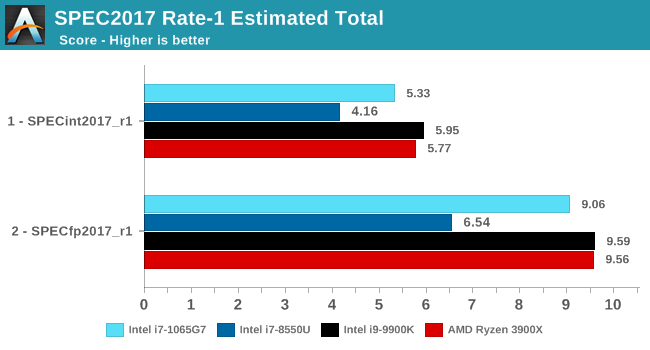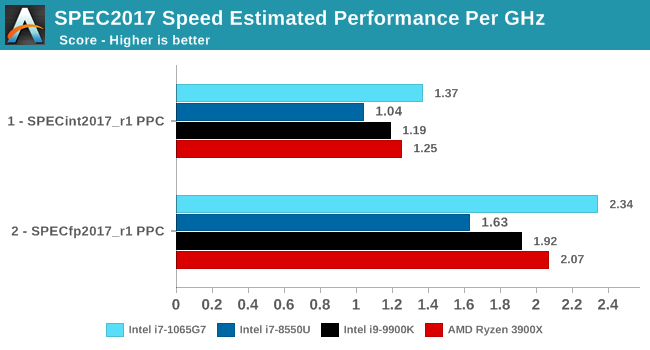The Ice Lake Benchmark Preview: Inside Intel's 10nm
by Dr. Ian Cutress on August 1, 2019 9:00 AM EST- Posted in
- CPUs
- Intel
- GPUs
- 10nm
- Core
- Ice Lake
- Cannon Lake
- Sunny Cove
- 10th Gen Core
Section by Andrei Frumusanu
SPEC2017 and SPEC2006 Results (15W)
SPEC2017 and SPEC2006 is a series of standardized tests used to probe the overall performance between different systems, different architectures, different microarchitectures, and setups. The code has to be compiled, and then the results can be submitted to an online database for comparsion. It covers a range of integer and floating point workloads, and can be very optimized for each CPU, so it is important to check how the benchmarks are being compiled and run.
We run the tests in a harness built through Windows Subsystem for Linux, developed by our own Andrei Frumusanu. WSL has some odd quirks, with one test not running due to a WSL fixed stack size, but for like-for-like testing is good enough. SPEC2006 is deprecated in favor of 2017, but remains an interesting comparison point in our data. Because our scores aren’t official submissions, as per SPEC guidelines we have to declare them as internal estimates from our part.
For compilers, we use LLVM both for C/C++ and Fortan tests, and for Fortran we’re using the Flang compiler. The rationale of using LLVM over GCC is better cross-platform comparisons to platforms that have only have LLVM support and future articles where we’ll investigate this aspect more. We’re not considering closed-sourced compilers such as MSVC or ICC.
clang version 8.0.0-svn350067-1~exp1+0~20181226174230.701~1.gbp6019f2 (trunk)
clang version 7.0.1 (ssh://git@github.com/flang-compiler/flang-driver.git
24bd54da5c41af04838bbe7b68f830840d47fc03)-Ofast -fomit-frame-pointer
-march=x86-64
-mtune=core-avx2
-mfma -mavx -mavx2
Our compiler flags are straightforward, with basic –Ofast and relevant ISA switches to allow for AVX2 instructions. Despite ICL supporting AVX-512, we have not currently implemented it, as it requires a much greater level of finesse with instruction packing. The best AVX-512 software uses hand-crafted intrinsics to provide the instructions, as per our 3PDM AVX-512 test later in the review.
For these comparisons, we will be picking out CPUs from across our dataset to provide context. Some of these might be higher power processors, it should be noted.
SPECint2006

Amongst SPECint2006, the one benchmark that really stands out beyond all the rest is the 473.astar. Here the new Sunny Cove core is showcasing some exceptional IPC gains, nearly doubling the performance over the 8550U even though it’s clocked 100MHz lower. The benchmark is extremely branch misprediction sensitive, and the only conclusion we can get to rationalise this increase is that the new branch predictors on Sunny Cove are doing an outstanding job and represent a massive improvement over Skylake.
456.hmmer and 464.h264ref are very execution bound and have the highest actual instructions per clock metrics in this suite. Here it’s very possible that Sunny Cove’s vastly increased out-of-order window is able to extract a lot more ILP out of the program and thus gain significant increases in IPC. It’s impressive that the 3.9GHz core here manages to match and outpace the 9900K’s 5GHz Skylake core.
Other benchmarks here which are limited by other µarch characteristics have various increases depending on the workload. Sunny Cove doubled L2 cache should certainly help with workloads like 403.gcc and others. However because we’re also memory latency limited on this platform the increases aren’t quite as large as we’d expect from a desktop variant of ICL.

In SPECfp2006, Sunny Cove’s wider out-of-order window can again be seen in tests such as 453.povray as the core is posting some impressive gains over the 8550U at similar clocks. 470.lbm is also instruction window as well as data store heavy – the core’s doubled store bandwidth here certainly helps it.

Overall in SPEC2006, the new i7-1065G7 beats a similarly clocked i7-8550U by a hefty 29% in the int suite and 34% in the fp suite. Of course this performance gap will be a lot smaller against 9th gen mobile H-parts at higher clocks, but these are also higher TDP products.
The 1065G7 comes quite close to the fastest desktop parts, however it’s likely it’ll need a desktop memory subsystem in order to catch up in total peak absolute performance.

Performance per clock increases on the new Sunny Cove architecture are outstandingly good. IPC increases against the mobile Skylake are 33 and 38% in the integer and fp suites, though we also have to keep in d mind these figures go beyond just the Sunny Cove architecture and also include improvements through the new LPDDR4X memory controllers.
Against a 9900K, although apples and oranges, we’re seeing 13% and 14% IPC increases. These figures likely would be higher on an eventual desktop Sunny Cove part.
SPEC2017



The SPEC2017 results look similar to the 2006 ones. Against the 8550U, we’re seeing grand performance uplifts, just shy of the best desktop processors.

Here the IPC increase also look extremely solid. In the SPECin2017 suite the Ice Lake part achieves a 14% increase over the 9900K, however we also see a very impressive 21% increase in the fp suite.
Overall in the 2017 suite, we’re seeing a 19% increase in IPC over the 9900K, which roughly matches Intel’s advertised metric of 18% IPC increase.










261 Comments
View All Comments
jcc5169 - Thursday, August 1, 2019 - link
It's like a long running Intel advertisement ......Ian Cutress - Thursday, August 1, 2019 - link
How so?jordanclock - Thursday, August 1, 2019 - link
Probably because you provided objective measurements instead of long winded conjecture.peevee - Friday, August 2, 2019 - link
"As for Ice Lake itself, our results lean towards Ice Lake outperforming Whiskey Lake, if only by a small margin."A laptop allowing more than 50W on a U chip and with cooler always running is certainly not representative of the real world performance a user would get from real systems. If Whiskey Lake results were obtained on a real system, then the results are not comparable enough that Ice Lake can actually be slower, especially in real world loads (note the performance on x264 and POV-Ray essentially has not changed).
But at least iGPU has improved nicely.
Samus - Saturday, August 3, 2019 - link
They have dedicated pages to 15w and 25w results. Not sure what you're on about about 'allowing more than 50W...' when they power limited the chip for specific-scenario benchmark results.Spunjji - Monday, August 5, 2019 - link
You may want to re-read that Power Results section - put simply, peevee's point still stands and your response is mistaken. At the 25W limit, the CPU spent more than 20 seconds operating between 50W and 35W before it finally dropped down. It's unlikely that the Coffee / Whiskey devices they tested allowed that sort of behaviour, as without a continuous 100% fan speed the thermals would have spiked and lowered the power limit far sooner. Even with the "power limits" you're talking about in place, the chip still boosts like that, so their benchmark results incorporate that behaviour. for any other company I might feel generously inclined, but Intel have already pulled a fast one multiple times by releasing CPUs that have nominally higher specifications but never reach their performance potential in shipping designs due to thermal constraints.Gondalf - Wednesday, January 8, 2020 - link
Spec suite (the reference) is a pretty loooong bench so the cpu stay at 15W all the time without your 50W. Your comment say a lot about you.yeeeeman - Wednesday, June 17, 2020 - link
Also, we not comparing power efficiency here but rather IPC of each core. And the bottom line is that Sunny Cove core has 5-10% better IPC than Zen 2.CSMR - Sunday, August 4, 2019 - link
There is no evidence that the iGPU has improved. We'd need a comparison against Iris Plus 655 to confirm that. We only know EUs have increased (64 vs 48) but EDRAM was removed.brakdoo - Thursday, August 1, 2019 - link
"First of all, I must say that Intel offering us to test a reference system in advance of a launch is a very good thing indeed"You are being played once again as a marketing tool for the Ice Lake launch. Don't tell me you don't see that.